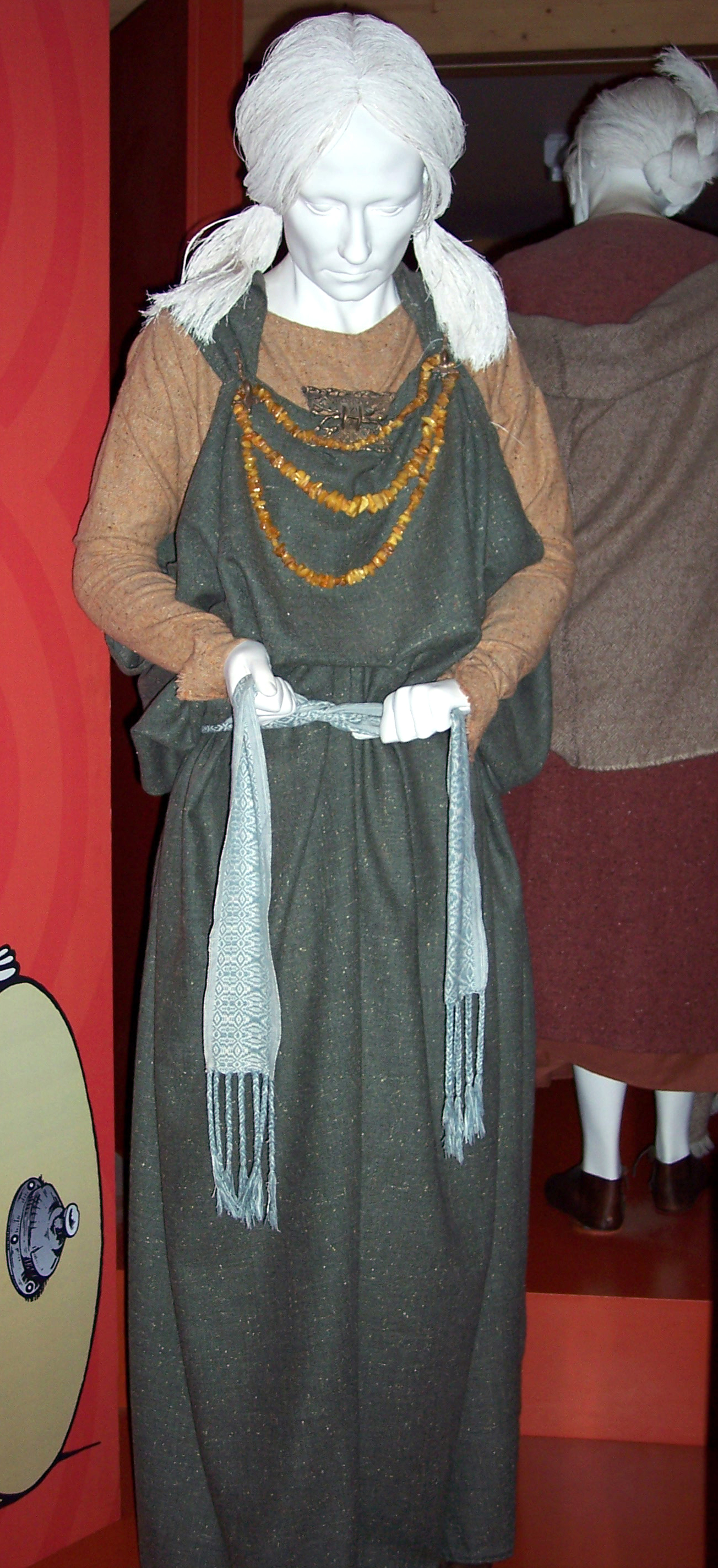
7th century Swede (Svear) Anglo Saxão, Anglo Saxon History, Sutton Hoo
The Anglo-Saxon people mainly wore clothes made of natural materials such as wool, cotton, linen etc. The men wore tunics with long sleeves made generally of wool. They had trousers held up with a belt containing pouches for knives and other tools. The women usually wore under-dresses of wool or linen and an outer-dress called "peplos".

Vikings Anglo Saxon Clothing, Medieval Clothing, Viking Costume
Medieval History Periods Anglo Saxons *410 - 1060 Anglo Saxon Clothes Anglo Saxon Clothes The Anglo Saxon period in England stretches from the 5th century to the 11th century and ended with the Norman Conquest of England. During this long period, Anglo Saxon clothing underwent a number of changes.

This is labeled 78th century Saxon, but her gown was out of fashion by
Anglo Saxon Clothing (1 - 60 of 263 results) Price ($) Shipping Recommended Sort by: Relevancy Medieval women's wool overcoat ready for delivery. Suitable for Vikings, Normans, Lombards, Anglo-Saxons, Alamans, Middle Ages (96) $184.74 Hack silver Viking Anglo Saxon Medieval hacksilver 925 sterling silver 22.36 grams (612) $42.00

Anglo Saxon Clothing NEN Gallery
The most common Anglo-Saxon clothes for women were black or brown woolen gowns. All women wore some type of head covering, but many did not wear shoes until the later Anglo-Saxon period. Women's clothing styles also changed as Christianity spread across Britain from the 6th century onwards.

Saxon Ealdorman by on DeviantArt Anglo
The Anglo-Saxons were a group of farmer-warriors who lived in Britain over a thousand years ago. Made up of three tribes who came over from Europe, they were called the Angle, Saxon, and Jute tribes. The two largest were the Angle and Saxon, which is how we've come to know them as the Anglo-Saxons today.

17 Best images about AngloSaxons on Pinterest Armors, Armour and Helmets
Saxon clothing Many Anglo-Saxon nobility fled to Scotland, Ireland and Scandinavia after the Norman conquest of England. Anglo-Saxon soldiers appear to have joined with the Byzantine Empire as mercenaries. Clothing styles from this point in England were considered Norman .

Reconstruction of Anglo Saxon mens clothing Anglo Saxon History
Anglo-Saxon clothing. Anglo-Saxon dress refers to the variety of early medieval European dress, or clothing, worn by the Anglo-Saxons from the time of their migration to Great Britain in the 5th century until the beginning of the Norman Conquest. The line of Saxon kings began with Egbert in 827 and ended when Harold II was defeated by William.

AngloSaxon gown, by Sew Mill. Anglo saxon clothing, Oc dress
Men's clothing in Anglo-Saxon society was typically of two types: clothing worn by the commoners and that worn by those of noble origins. Commoners usually wore tunics made of coarse wool and in some cases, woolen trousers as well. Men of nobility wore trousers or leggings, better-made tunics with cloaks on top.

Anglo Saxon woman's dress Anglo saxon clothing, Anglo saxon, Saxon
English medieval clothing. The Medieval period in England is usually classified as the time between the fall of the Roman Empire to the beginning of the Renaissance, roughly the years AD 410-1485. For various peoples living in England, the Anglo-Saxons, Anglo-Danes, Normans and Britons, clothing in the medieval era differed widely for men and.

Anglo Saxon woman's dress Anglo saxon clothing, Medieval clothing
The Anglo-Saxon fashion and costume history. England c. 460 to 1066. 11/22/16 by world4 comment 1 The Anglo-Saxon The dress of the Anglo-Saxon man. Head-gear.— Banded Phrygian cap. Cloak.— Of blue cloth embroidered. Tunica.— Green cloth embroidered. Stockings.— Red cloth cross-gartered yellow.

AngloSaxon men's wear; disregard the face front to the helmet. This
The Anglo-Saxons, known for their historical significance and cultural impact, have a rich and vibrant clothing heritage. Their style of dressing was not only a necessity but also a representation of their status, occupation, and the region they hailed from.

11th century anglo saxon clothing Google Search Medieval Life the
Anglo-Saxon Clothing, 6-9th century CE (Illustration) - World History Encyclopedia Anglo-Saxon Clothing, 6-9th century CE Illustration by Albert Kretschmer published on 27 June 2018 Download Full Size Image An illustration of the typical clothing worn by Anglo- Saxons in medieval England, c. 500 - c. 1000 CE. ('Costumes of all Nations', 1882 CE)

Hey Ma, look what I made! Suvia’s Letters Medieval clothing, Viking
This article addresses the evidence for Anglo-Saxon dress in relation to these criteria. From the evidence of grave-goods, it is possible to sketch reconstructions of clothing. Women's costume changed several times during the Anglo-Saxon period, apparently in response to foreign and religious stimuli, men's hardly at all.

AngloSaxon clothes women Anglo saxon clothing, Anglo saxon, World
Updated: May 23, 2021 How did the elite in Anglo-Saxon England use textiles and clothes to express their status and power? As an archaeologist, can we ever find evidence of this material culture, or is it all hypothetical?

Pin page
Anglo-Saxon Clothing, 6-9th century CE Albert Kretschmer (Public Domain) Both sexes wore long-sleeved tunics which had either a low-cut neck or a slit down the front so they could be put on over the head and then tied at the neck, sometimes with a brooch.

Anglo Saxon Clothing Stock Photos & Anglo Saxon Clothing Stock Images
5th and 6th centuries Men wore wool or linen hip-length undershirts with long sleeves, and probably loin-cloths. Woollen trousers were held up with a belt threaded through loops. A tunic was pulled over the head, and reached down to the knees. It was usually decorated at the wrists, neck and hem, and was long-sleeved.